International tourism organizations (10) Henryk Handszuh Fmr. Director,
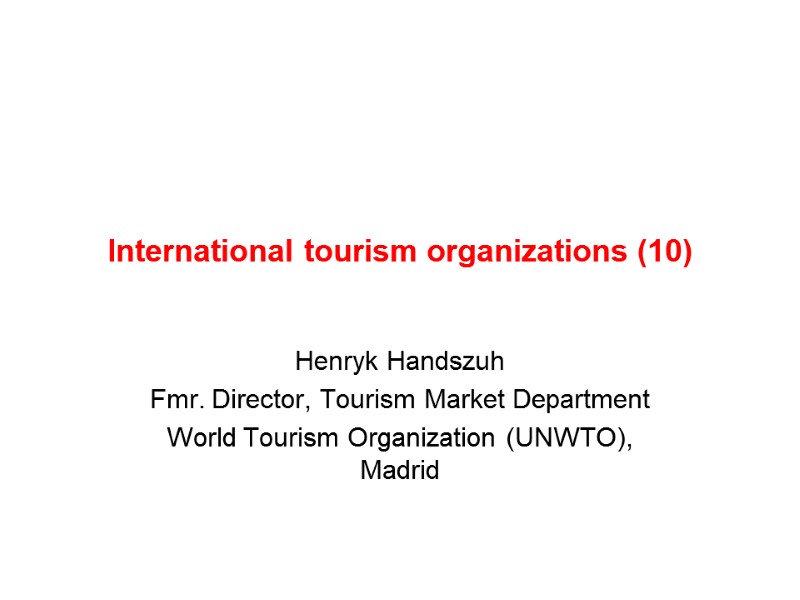
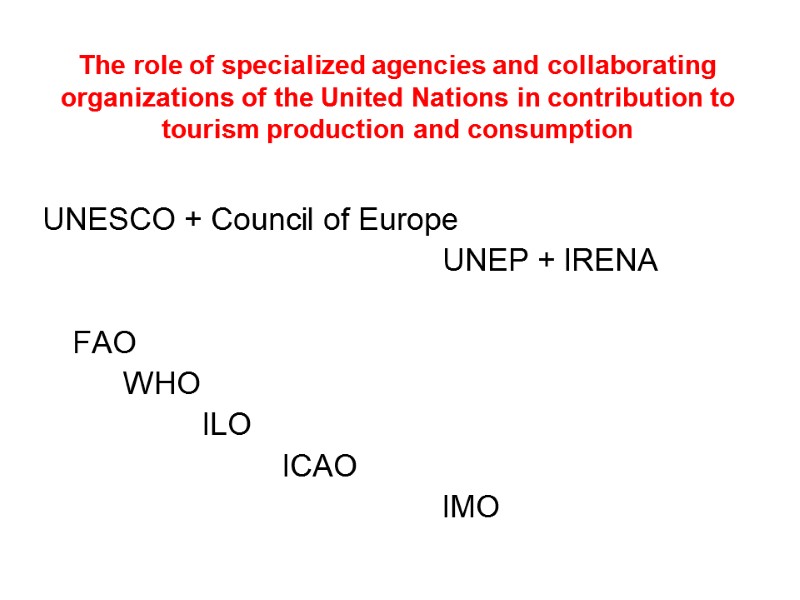
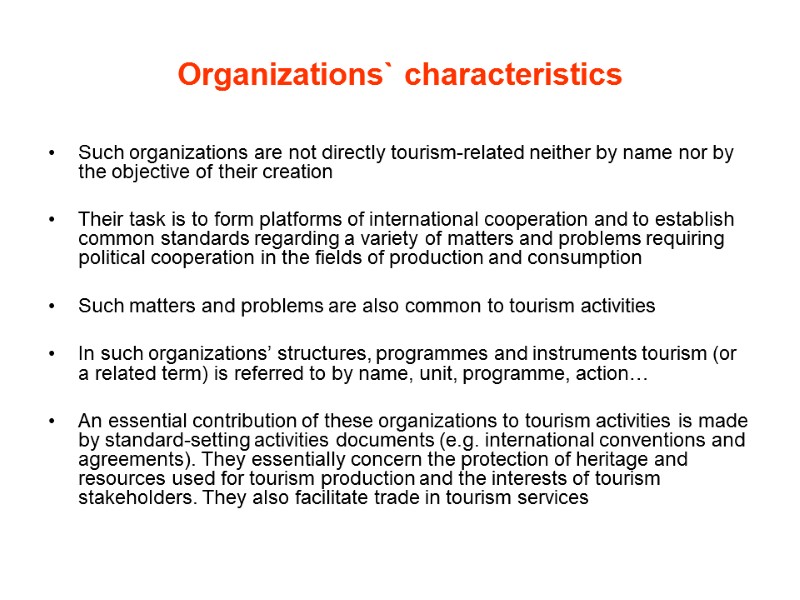
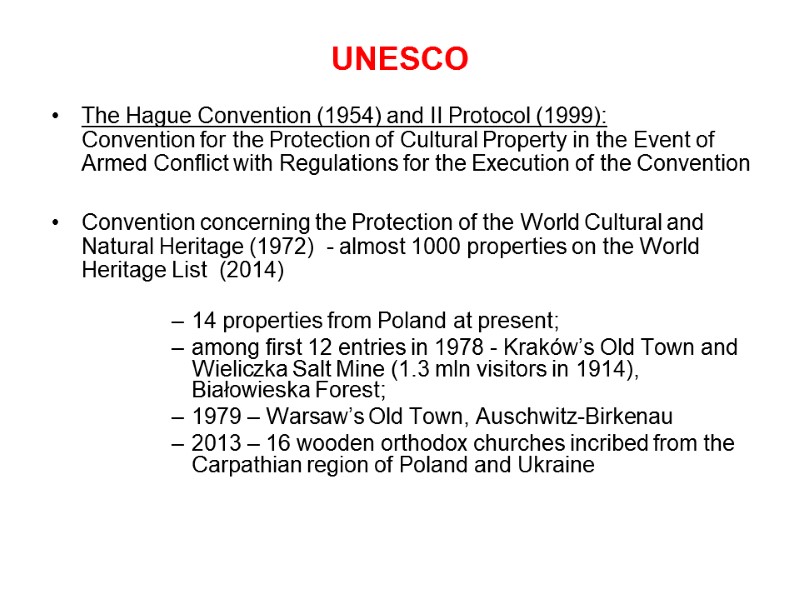
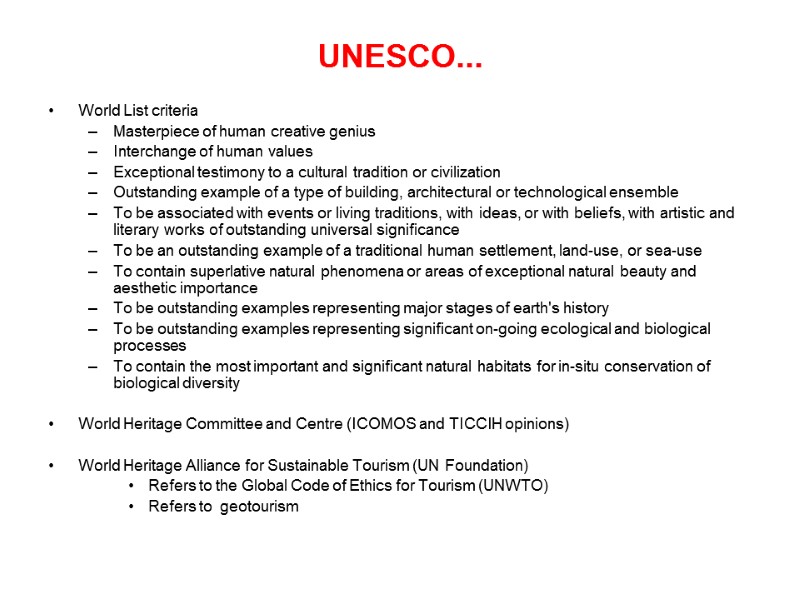
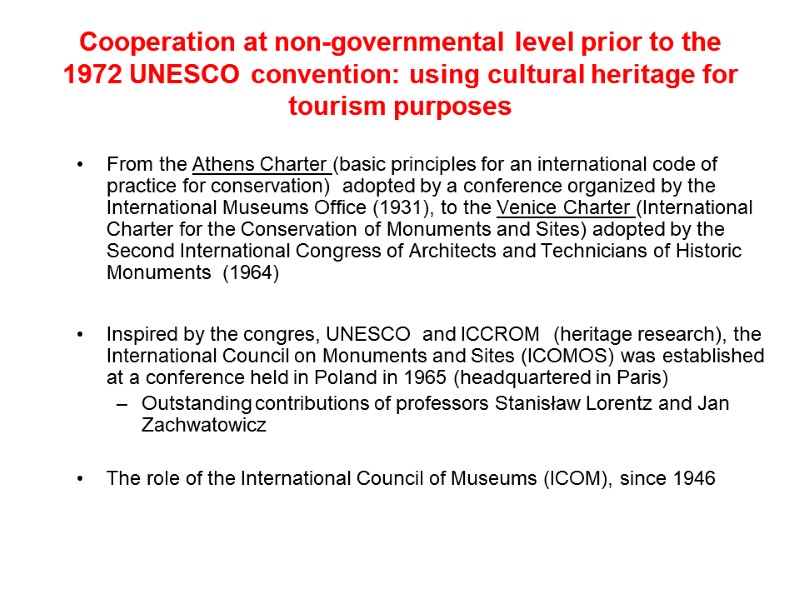
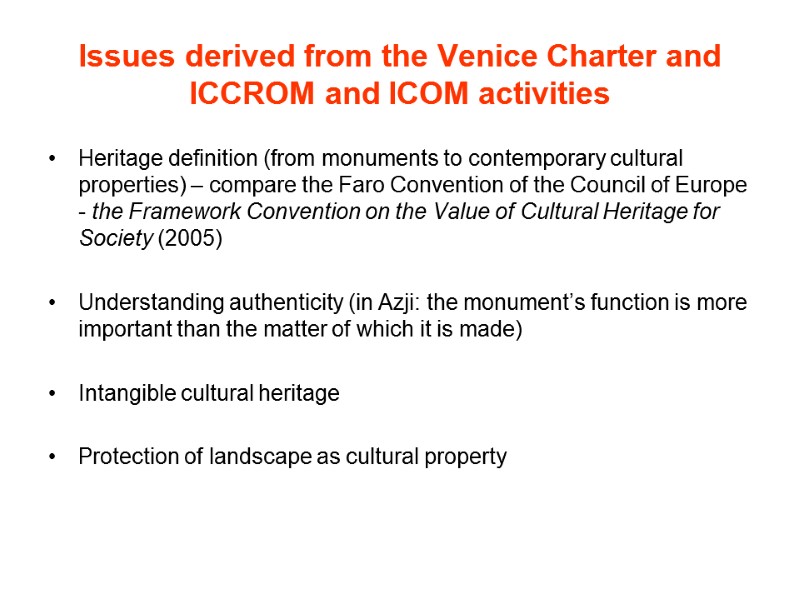
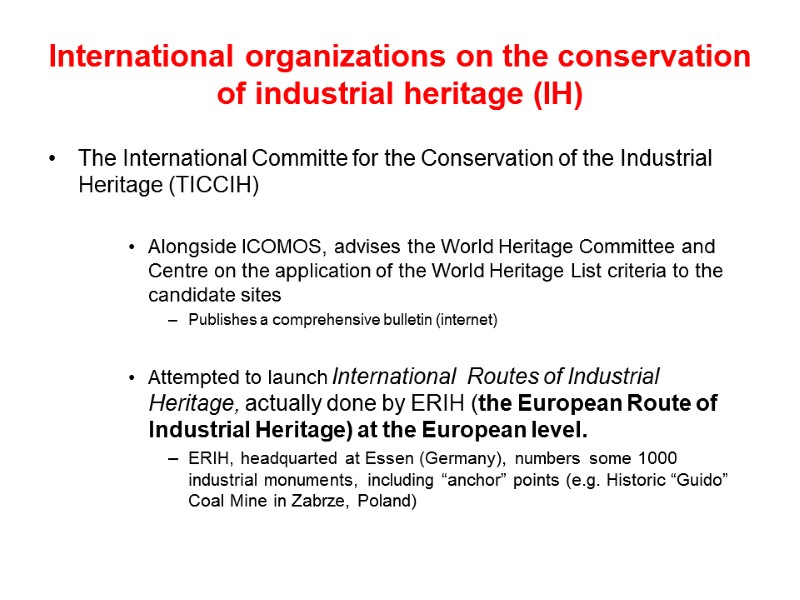
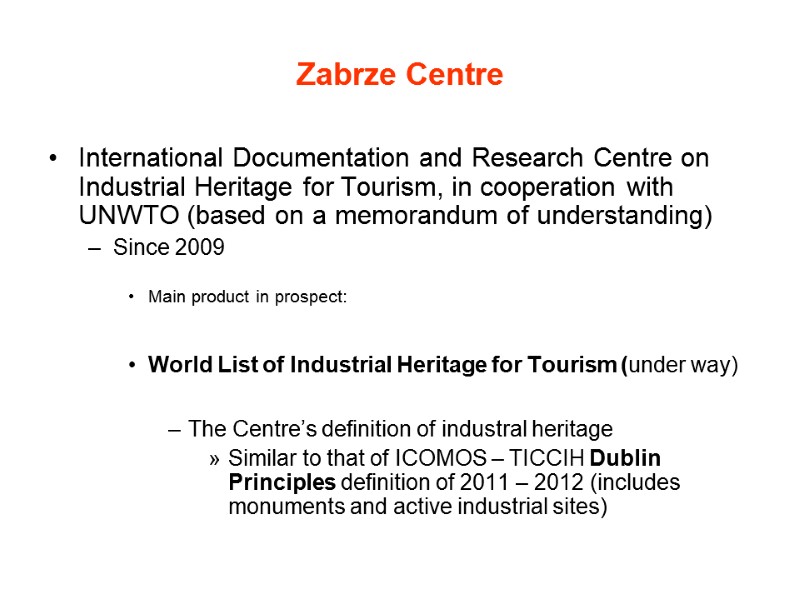
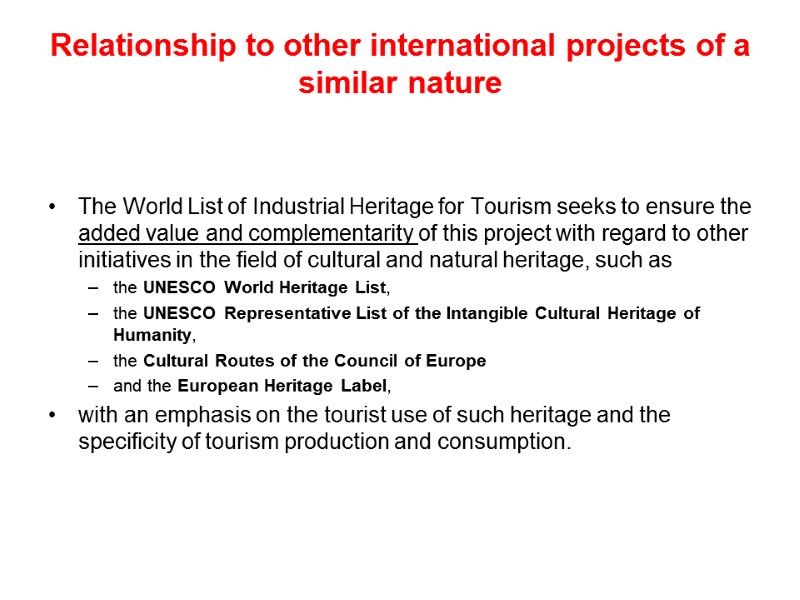
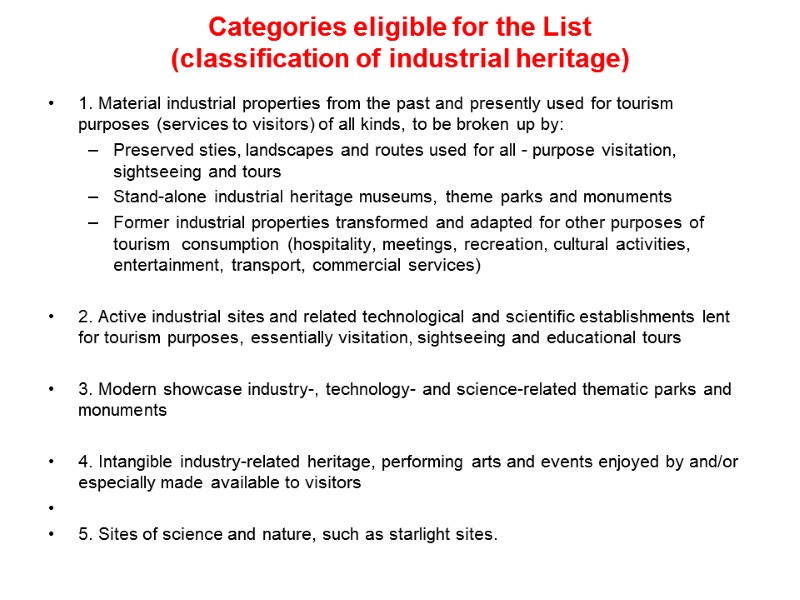
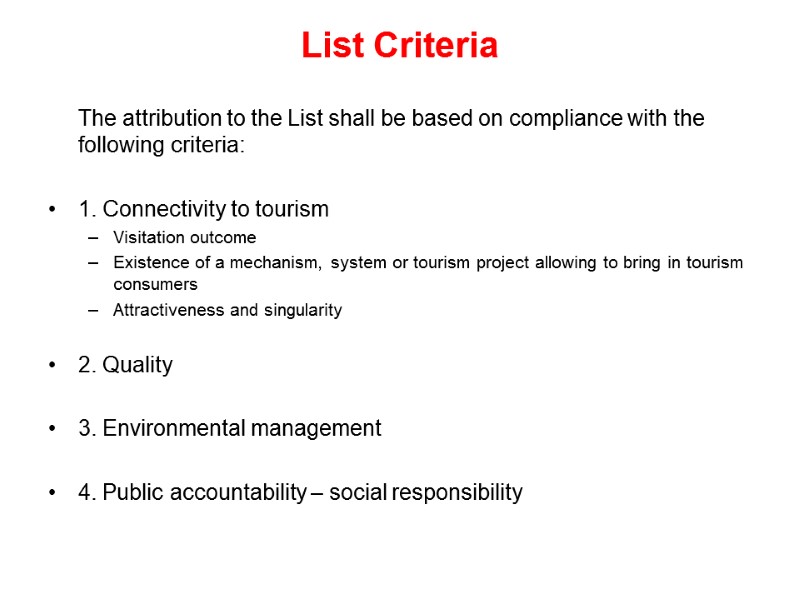
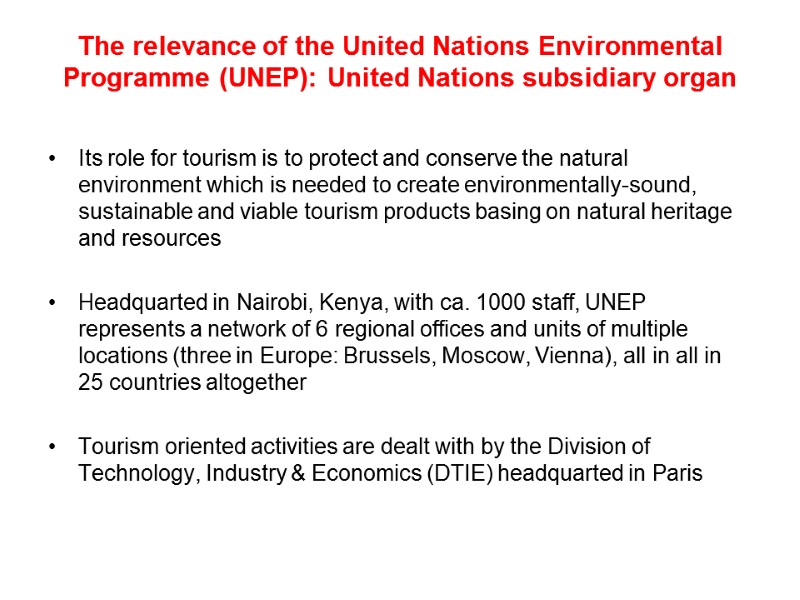
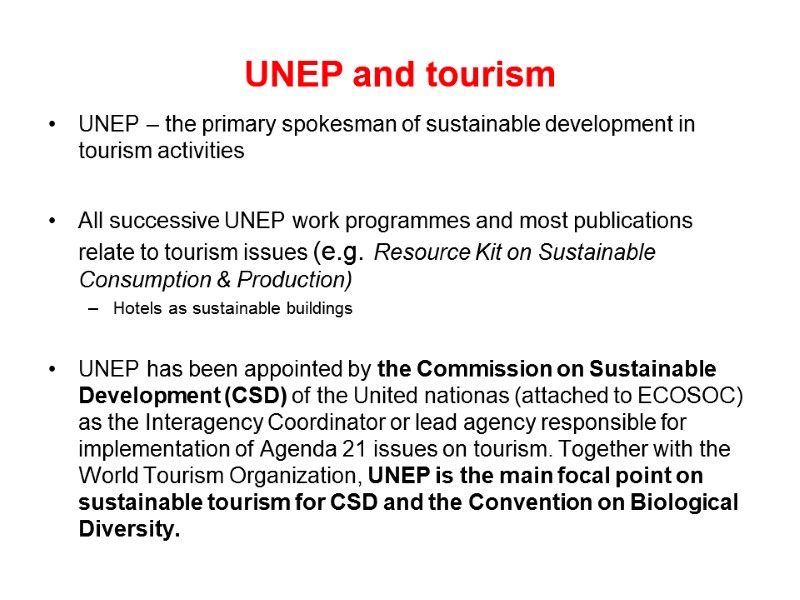
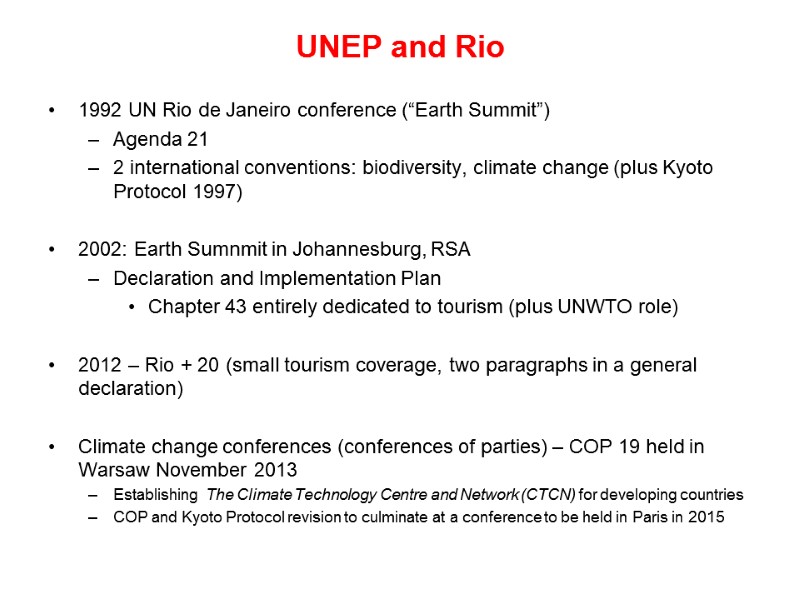
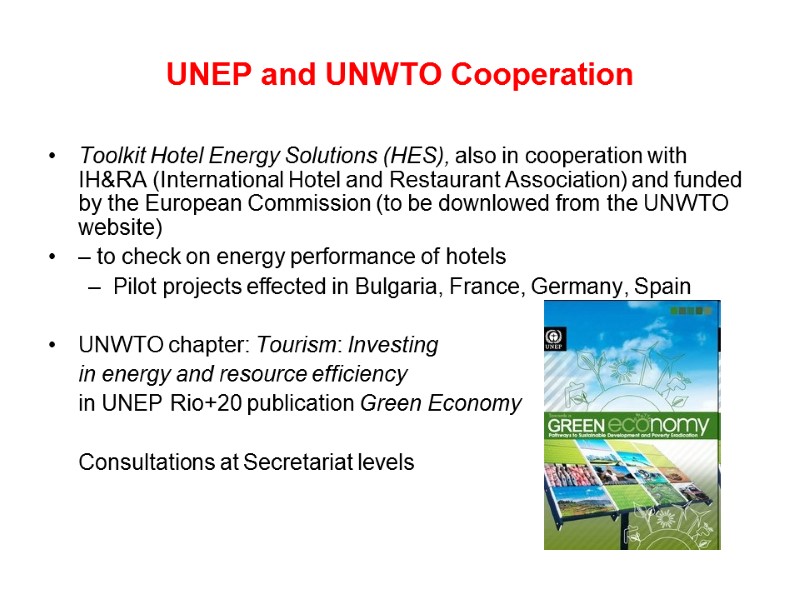
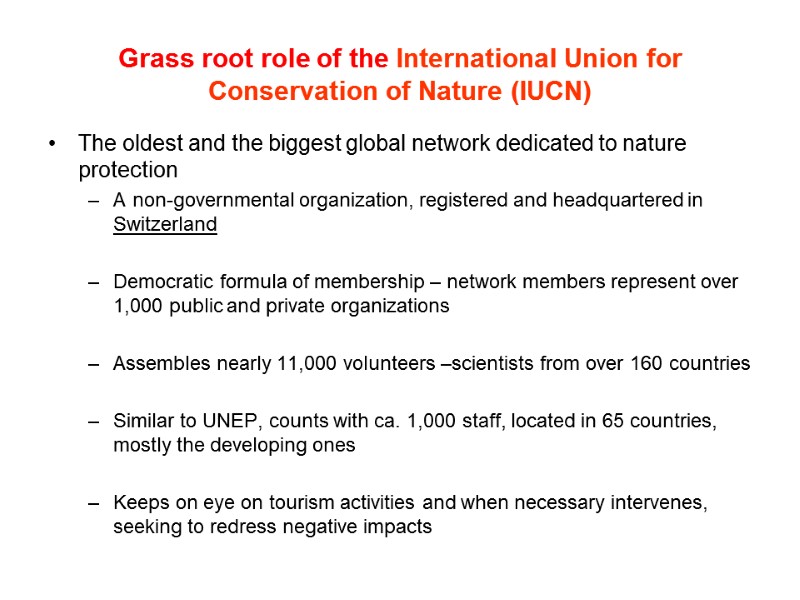
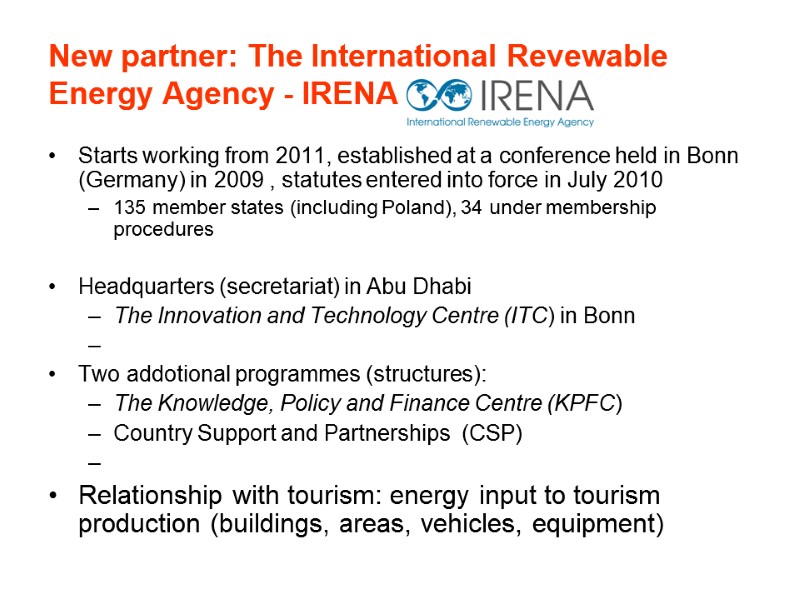
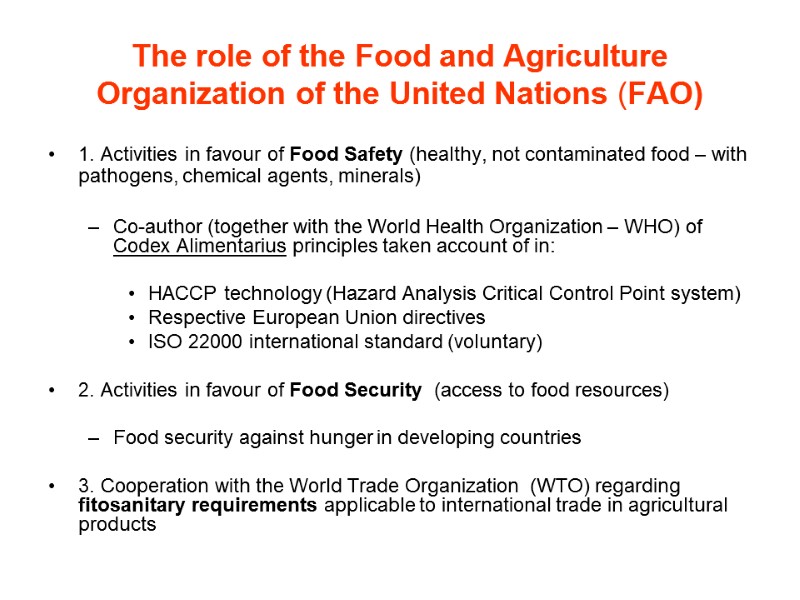
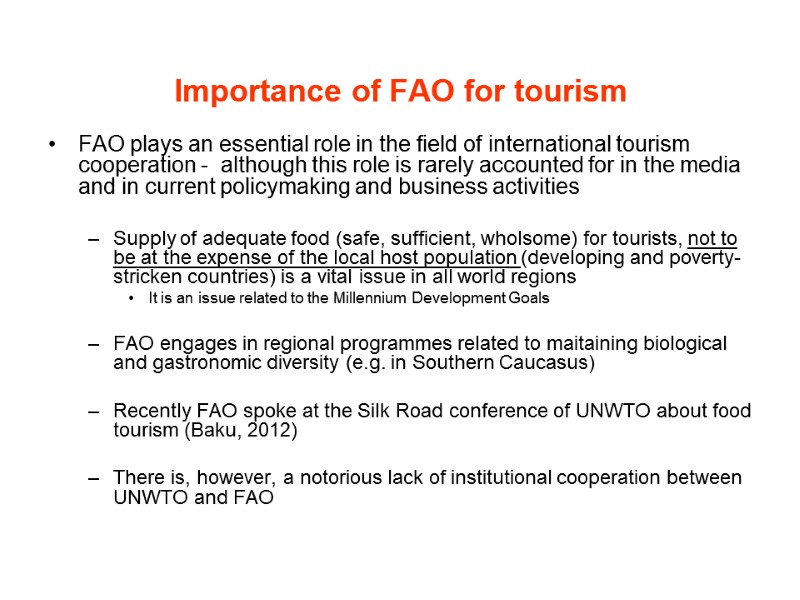
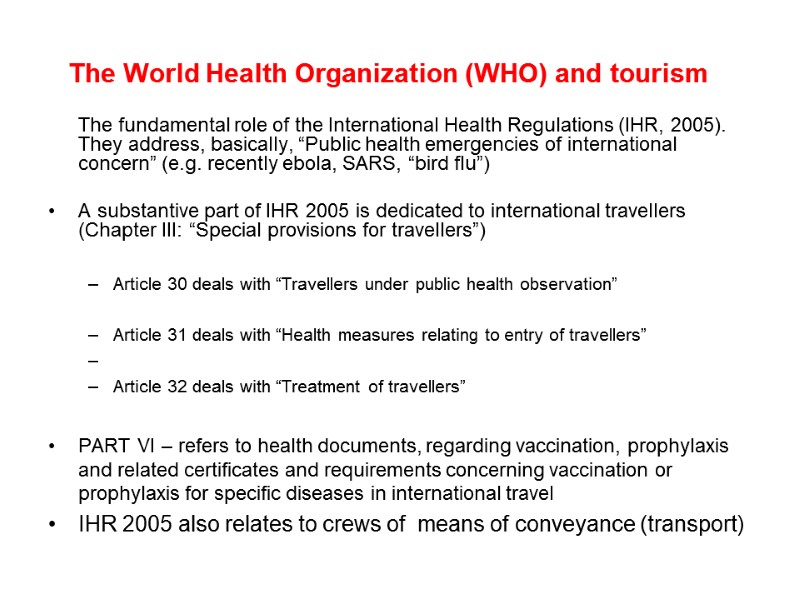
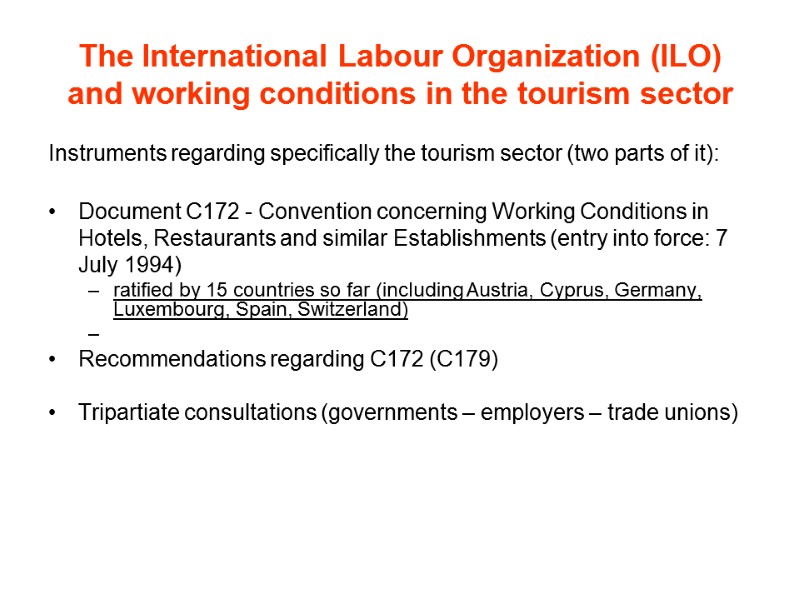
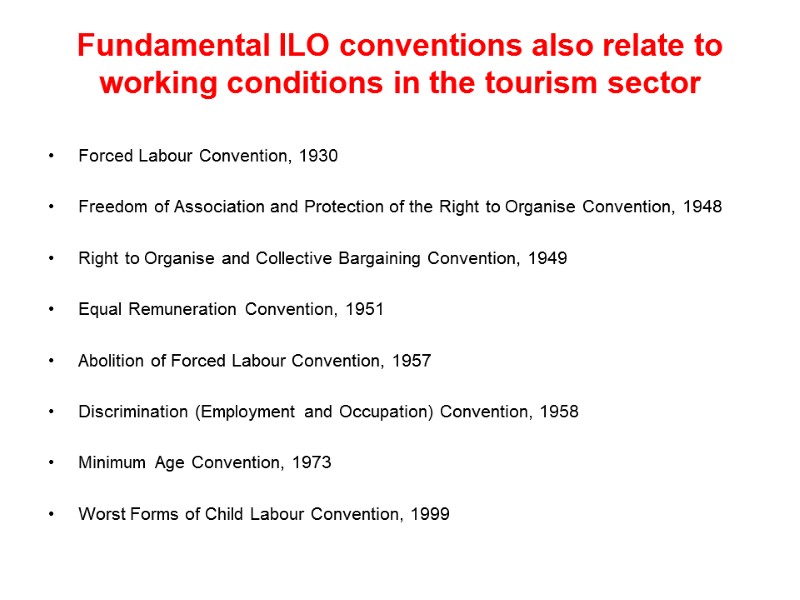
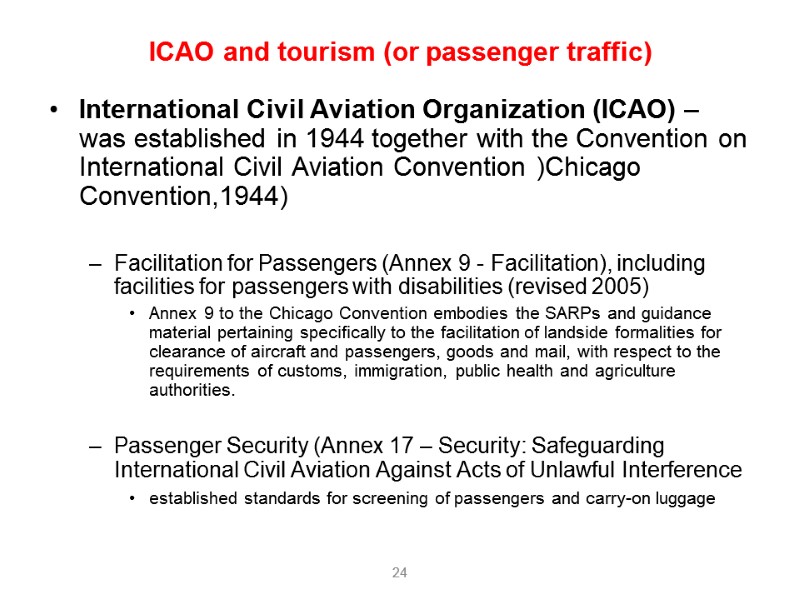
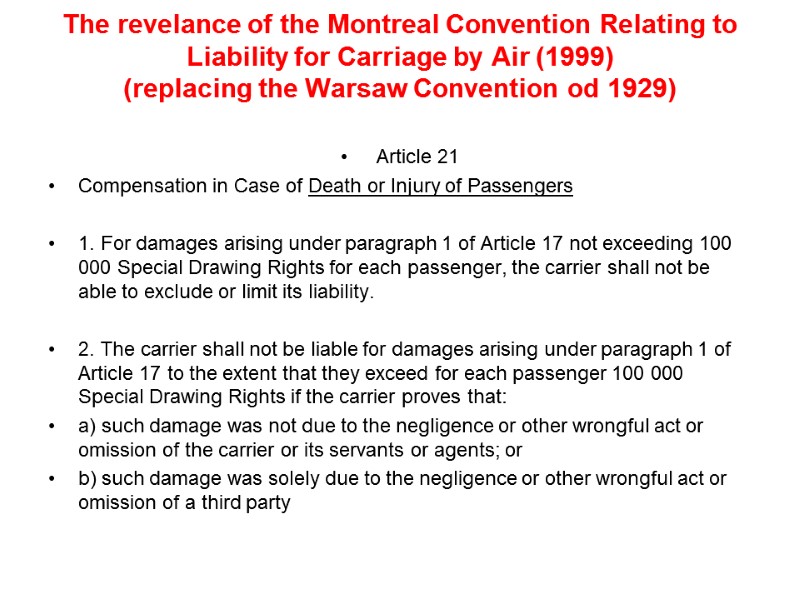
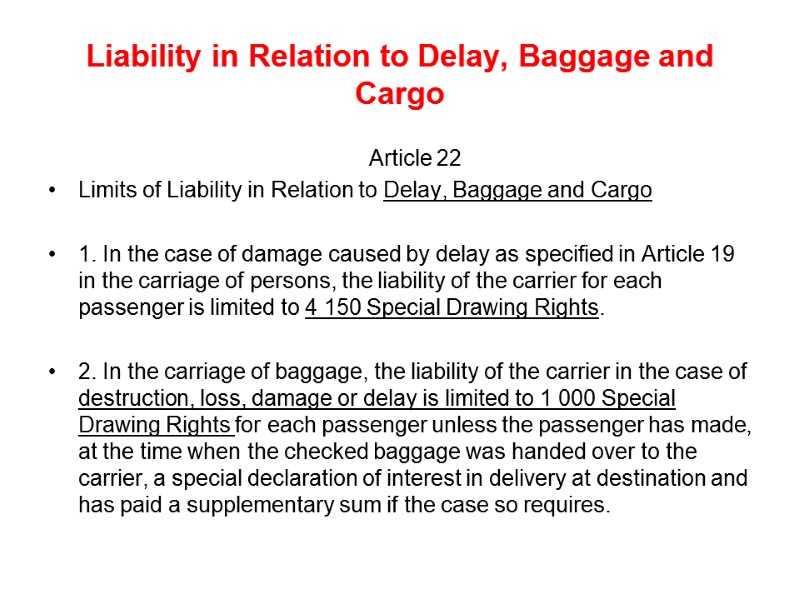
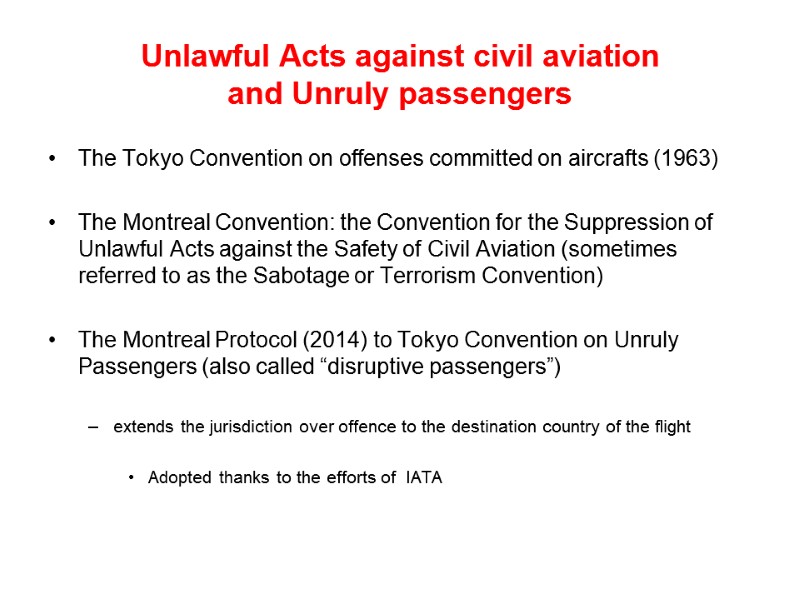
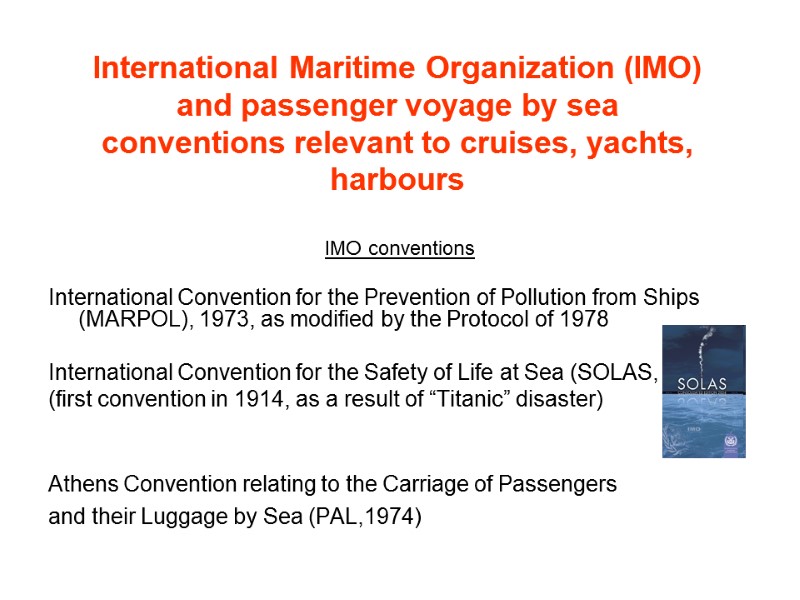
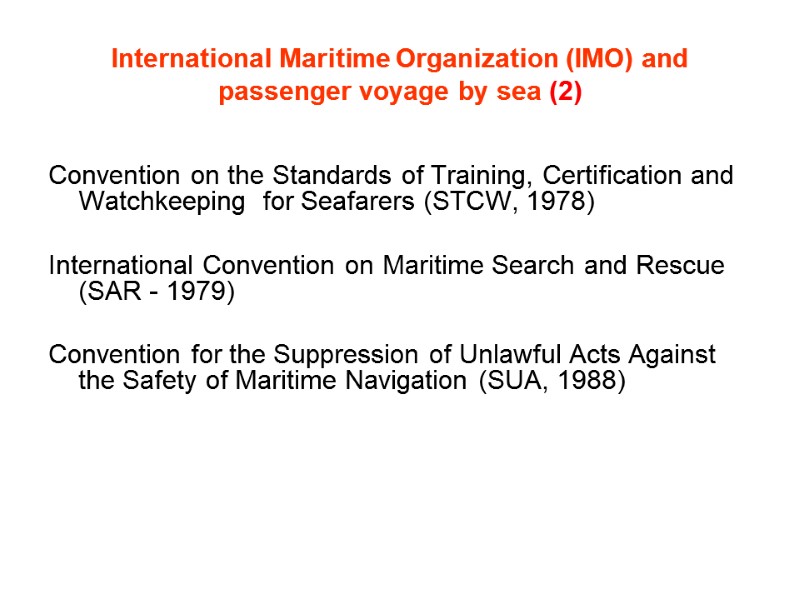
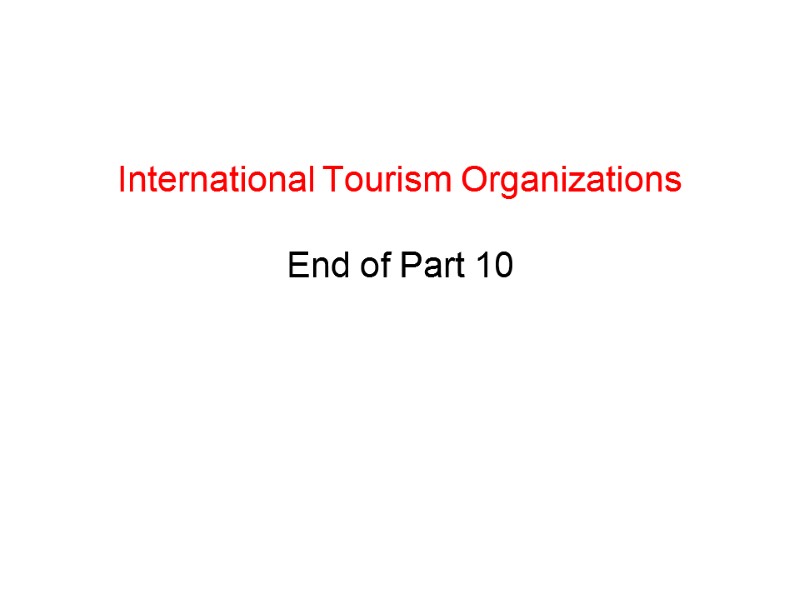
6694-ito10_-_spec_.ppt
- Количество слайдов: 30
 International tourism organizations (10) Henryk Handszuh Fmr. Director, Tourism Market Department World Tourism Organization (UNWTO), Madrid
International tourism organizations (10) Henryk Handszuh Fmr. Director, Tourism Market Department World Tourism Organization (UNWTO), Madrid
 The role of specialized agencies and collaborating organizations of the United Nations in contribution to tourism production and consumption UNESCO + Council of Europe UNEP + IRENA FAO WHO ILO ICAO IMO
The role of specialized agencies and collaborating organizations of the United Nations in contribution to tourism production and consumption UNESCO + Council of Europe UNEP + IRENA FAO WHO ILO ICAO IMO
 Organizations` characteristics Such organizations are not directly tourism-related neither by name nor by the objective of their creation Their task is to form platforms of international cooperation and to establish common standards regarding a variety of matters and problems requiring political cooperation in the fields of production and consumption Such matters and problems are also common to tourism activities In such organizations’ structures, programmes and instruments tourism (or a related term) is referred to by name, unit, programme, action… An essential contribution of these organizations to tourism activities is made by standard-setting activities documents (e.g. international conventions and agreements). They essentially concern the protection of heritage and resources used for tourism production and the interests of tourism stakeholders. They also facilitate trade in tourism services
Organizations` characteristics Such organizations are not directly tourism-related neither by name nor by the objective of their creation Their task is to form platforms of international cooperation and to establish common standards regarding a variety of matters and problems requiring political cooperation in the fields of production and consumption Such matters and problems are also common to tourism activities In such organizations’ structures, programmes and instruments tourism (or a related term) is referred to by name, unit, programme, action… An essential contribution of these organizations to tourism activities is made by standard-setting activities documents (e.g. international conventions and agreements). They essentially concern the protection of heritage and resources used for tourism production and the interests of tourism stakeholders. They also facilitate trade in tourism services
 UNESCO The Hague Convention (1954) and II Protocol (1999): Convention for the Protection of Cultural Property in the Event of Armed Conflict with Regulations for the Execution of the Convention Convention concerning the Protection of the World Cultural and Natural Heritage (1972) - almost 1000 properties on the World Heritage List (2014) 14 properties from Poland at present; among first 12 entries in 1978 - Kraków’s Old Town and Wieliczka Salt Mine (1.3 mln visitors in 1914), Białowieska Forest; 1979 – Warsaw’s Old Town, Auschwitz-Birkenau 2013 – 16 wooden orthodox churches incribed from the Carpathian region of Poland and Ukraine
UNESCO The Hague Convention (1954) and II Protocol (1999): Convention for the Protection of Cultural Property in the Event of Armed Conflict with Regulations for the Execution of the Convention Convention concerning the Protection of the World Cultural and Natural Heritage (1972) - almost 1000 properties on the World Heritage List (2014) 14 properties from Poland at present; among first 12 entries in 1978 - Kraków’s Old Town and Wieliczka Salt Mine (1.3 mln visitors in 1914), Białowieska Forest; 1979 – Warsaw’s Old Town, Auschwitz-Birkenau 2013 – 16 wooden orthodox churches incribed from the Carpathian region of Poland and Ukraine
 UNESCO... World List criteria Masterpiece of human creative genius Interchange of human values Exceptional testimony to a cultural tradition or civilization Outstanding example of a type of building, architectural or technological ensemble To be associated with events or living traditions, with ideas, or with beliefs, with artistic and literary works of outstanding universal significance To be an outstanding example of a traditional human settlement, land-use, or sea-use To contain superlative natural phenomena or areas of exceptional natural beauty and aesthetic importance To be outstanding examples representing major stages of earth's history To be outstanding examples representing significant on-going ecological and biological processes To contain the most important and significant natural habitats for in-situ conservation of biological diversity World Heritage Committee and Centre (ICOMOS and TICCIH opinions) World Heritage Alliance for Sustainable Tourism (UN Foundation) Refers to the Global Code of Ethics for Tourism (UNWTO) Refers to geotourism
UNESCO... World List criteria Masterpiece of human creative genius Interchange of human values Exceptional testimony to a cultural tradition or civilization Outstanding example of a type of building, architectural or technological ensemble To be associated with events or living traditions, with ideas, or with beliefs, with artistic and literary works of outstanding universal significance To be an outstanding example of a traditional human settlement, land-use, or sea-use To contain superlative natural phenomena or areas of exceptional natural beauty and aesthetic importance To be outstanding examples representing major stages of earth's history To be outstanding examples representing significant on-going ecological and biological processes To contain the most important and significant natural habitats for in-situ conservation of biological diversity World Heritage Committee and Centre (ICOMOS and TICCIH opinions) World Heritage Alliance for Sustainable Tourism (UN Foundation) Refers to the Global Code of Ethics for Tourism (UNWTO) Refers to geotourism
 Cooperation at non-governmental level prior to the 1972 UNESCO convention: using cultural heritage for tourism purposes From the Athens Charter (basic principles for an international code of practice for conservation) adopted by a conference organized by the International Museums Office (1931), to the Venice Charter (International Charter for the Conservation of Monuments and Sites) adopted by the Second International Congress of Architects and Technicians of Historic Monuments (1964) Inspired by the congres, UNESCO and ICCROM (heritage research), the International Council on Monuments and Sites (ICOMOS) was established at a conference held in Poland in 1965 (headquartered in Paris) Outstanding contributions of professors Stanisław Lorentz and Jan Zachwatowicz The role of the International Council of Museums (ICOM), since 1946
Cooperation at non-governmental level prior to the 1972 UNESCO convention: using cultural heritage for tourism purposes From the Athens Charter (basic principles for an international code of practice for conservation) adopted by a conference organized by the International Museums Office (1931), to the Venice Charter (International Charter for the Conservation of Monuments and Sites) adopted by the Second International Congress of Architects and Technicians of Historic Monuments (1964) Inspired by the congres, UNESCO and ICCROM (heritage research), the International Council on Monuments and Sites (ICOMOS) was established at a conference held in Poland in 1965 (headquartered in Paris) Outstanding contributions of professors Stanisław Lorentz and Jan Zachwatowicz The role of the International Council of Museums (ICOM), since 1946
 Issues derived from the Venice Charter and ICCROM and ICOM activities Heritage definition (from monuments to contemporary cultural properties) – compare the Faro Convention of the Council of Europe - the Framework Convention on the Value of Cultural Heritage for Society (2005) Understanding authenticity (in Azji: the monument’s function is more important than the matter of which it is made) Intangible cultural heritage Protection of landscape as cultural property
Issues derived from the Venice Charter and ICCROM and ICOM activities Heritage definition (from monuments to contemporary cultural properties) – compare the Faro Convention of the Council of Europe - the Framework Convention on the Value of Cultural Heritage for Society (2005) Understanding authenticity (in Azji: the monument’s function is more important than the matter of which it is made) Intangible cultural heritage Protection of landscape as cultural property
 International organizations on the conservation of industrial heritage (IH) The International Committe for the Conservation of the Industrial Heritage (TICCIH) Alongside ICOMOS, advises the World Heritage Committee and Centre on the application of the World Heritage List criteria to the candidate sites Publishes a comprehensive bulletin (internet) Attempted to launch International Routes of Industrial Heritage, actually done by ERIH (the European Route of Industrial Heritage) at the European level. ERIH, headquarted at Essen (Germany), numbers some 1000 industrial monuments, including “anchor” points (e.g. Historic “Guido” Coal Mine in Zabrze, Poland)
International organizations on the conservation of industrial heritage (IH) The International Committe for the Conservation of the Industrial Heritage (TICCIH) Alongside ICOMOS, advises the World Heritage Committee and Centre on the application of the World Heritage List criteria to the candidate sites Publishes a comprehensive bulletin (internet) Attempted to launch International Routes of Industrial Heritage, actually done by ERIH (the European Route of Industrial Heritage) at the European level. ERIH, headquarted at Essen (Germany), numbers some 1000 industrial monuments, including “anchor” points (e.g. Historic “Guido” Coal Mine in Zabrze, Poland)
 Zabrze Centre International Documentation and Research Centre on Industrial Heritage for Tourism, in cooperation with UNWTO (based on a memorandum of understanding) Since 2009 Main product in prospect: World List of Industrial Heritage for Tourism (under way) The Centre’s definition of industral heritage Similar to that of ICOMOS – TICCIH Dublin Principles definition of 2011 – 2012 (includes monuments and active industrial sites)
Zabrze Centre International Documentation and Research Centre on Industrial Heritage for Tourism, in cooperation with UNWTO (based on a memorandum of understanding) Since 2009 Main product in prospect: World List of Industrial Heritage for Tourism (under way) The Centre’s definition of industral heritage Similar to that of ICOMOS – TICCIH Dublin Principles definition of 2011 – 2012 (includes monuments and active industrial sites)
 Relationship to other international projects of a similar nature The World List of Industrial Heritage for Tourism seeks to ensure the added value and complementarity of this project with regard to other initiatives in the field of cultural and natural heritage, such as the UNESCO World Heritage List, the UNESCO Representative List of the Intangible Cultural Heritage of Humanity, the Cultural Routes of the Council of Europe and the European Heritage Label, with an emphasis on the tourist use of such heritage and the specificity of tourism production and consumption.
Relationship to other international projects of a similar nature The World List of Industrial Heritage for Tourism seeks to ensure the added value and complementarity of this project with regard to other initiatives in the field of cultural and natural heritage, such as the UNESCO World Heritage List, the UNESCO Representative List of the Intangible Cultural Heritage of Humanity, the Cultural Routes of the Council of Europe and the European Heritage Label, with an emphasis on the tourist use of such heritage and the specificity of tourism production and consumption.
 Categories eligible for the List (classification of industrial heritage) 1. Material industrial properties from the past and presently used for tourism purposes (services to visitors) of all kinds, to be broken up by: Preserved sties, landscapes and routes used for all - purpose visitation, sightseeing and tours Stand-alone industrial heritage museums, theme parks and monuments Former industrial properties transformed and adapted for other purposes of tourism consumption (hospitality, meetings, recreation, cultural activities, entertainment, transport, commercial services) 2. Active industrial sites and related technological and scientific establishments lent for tourism purposes, essentially visitation, sightseeing and educational tours 3. Modern showcase industry-, technology- and science-related thematic parks and monuments 4. Intangible industry-related heritage, performing arts and events enjoyed by and/or especially made available to visitors 5. Sites of science and nature, such as starlight sites.
Categories eligible for the List (classification of industrial heritage) 1. Material industrial properties from the past and presently used for tourism purposes (services to visitors) of all kinds, to be broken up by: Preserved sties, landscapes and routes used for all - purpose visitation, sightseeing and tours Stand-alone industrial heritage museums, theme parks and monuments Former industrial properties transformed and adapted for other purposes of tourism consumption (hospitality, meetings, recreation, cultural activities, entertainment, transport, commercial services) 2. Active industrial sites and related technological and scientific establishments lent for tourism purposes, essentially visitation, sightseeing and educational tours 3. Modern showcase industry-, technology- and science-related thematic parks and monuments 4. Intangible industry-related heritage, performing arts and events enjoyed by and/or especially made available to visitors 5. Sites of science and nature, such as starlight sites.
 List Criteria The attribution to the List shall be based on compliance with the following criteria: 1. Connectivity to tourism Visitation outcome Existence of a mechanism, system or tourism project allowing to bring in tourism consumers Attractiveness and singularity 2. Quality 3. Environmental management 4. Public accountability – social responsibility
List Criteria The attribution to the List shall be based on compliance with the following criteria: 1. Connectivity to tourism Visitation outcome Existence of a mechanism, system or tourism project allowing to bring in tourism consumers Attractiveness and singularity 2. Quality 3. Environmental management 4. Public accountability – social responsibility
 The relevance of the United Nations Environmental Programme (UNEP): United Nations subsidiary organ Its role for tourism is to protect and conserve the natural environment which is needed to create environmentally-sound, sustainable and viable tourism products basing on natural heritage and resources Headquarted in Nairobi, Kenya, with ca. 1000 staff, UNEP represents a network of 6 regional offices and units of multiple locations (three in Europe: Brussels, Moscow, Vienna), all in all in 25 countries altogether Tourism oriented activities are dealt with by the Division of Technology, Industry & Economics (DTIE) headquarted in Paris
The relevance of the United Nations Environmental Programme (UNEP): United Nations subsidiary organ Its role for tourism is to protect and conserve the natural environment which is needed to create environmentally-sound, sustainable and viable tourism products basing on natural heritage and resources Headquarted in Nairobi, Kenya, with ca. 1000 staff, UNEP represents a network of 6 regional offices and units of multiple locations (three in Europe: Brussels, Moscow, Vienna), all in all in 25 countries altogether Tourism oriented activities are dealt with by the Division of Technology, Industry & Economics (DTIE) headquarted in Paris
 UNEP and tourism UNEP – the primary spokesman of sustainable development in tourism activities All successive UNEP work programmes and most publications relate to tourism issues (e.g. Resource Kit on Sustainable Consumption & Production) Hotels as sustainable buildings UNEP has been appointed by the Commission on Sustainable Development (CSD) of the United nationas (attached to ECOSOC) as the Interagency Coordinator or lead agency responsible for implementation of Agenda 21 issues on tourism. Together with the World Tourism Organization, UNEP is the main focal point on sustainable tourism for CSD and the Convention on Biological Diversity.
UNEP and tourism UNEP – the primary spokesman of sustainable development in tourism activities All successive UNEP work programmes and most publications relate to tourism issues (e.g. Resource Kit on Sustainable Consumption & Production) Hotels as sustainable buildings UNEP has been appointed by the Commission on Sustainable Development (CSD) of the United nationas (attached to ECOSOC) as the Interagency Coordinator or lead agency responsible for implementation of Agenda 21 issues on tourism. Together with the World Tourism Organization, UNEP is the main focal point on sustainable tourism for CSD and the Convention on Biological Diversity.
 UNEP and Rio 1992 UN Rio de Janeiro conference (“Earth Summit”) Agenda 21 2 international conventions: biodiversity, climate change (plus Kyoto Protocol 1997) 2002: Earth Sumnmit in Johannesburg, RSA Declaration and Implementation Plan Chapter 43 entirely dedicated to tourism (plus UNWTO role) 2012 – Rio + 20 (small tourism coverage, two paragraphs in a general declaration) Climate change conferences (conferences of parties) – COP 19 held in Warsaw November 2013 Establishing The Climate Technology Centre and Network (CTCN) for developing countries COP and Kyoto Protocol revision to culminate at a conference to be held in Paris in 2015
UNEP and Rio 1992 UN Rio de Janeiro conference (“Earth Summit”) Agenda 21 2 international conventions: biodiversity, climate change (plus Kyoto Protocol 1997) 2002: Earth Sumnmit in Johannesburg, RSA Declaration and Implementation Plan Chapter 43 entirely dedicated to tourism (plus UNWTO role) 2012 – Rio + 20 (small tourism coverage, two paragraphs in a general declaration) Climate change conferences (conferences of parties) – COP 19 held in Warsaw November 2013 Establishing The Climate Technology Centre and Network (CTCN) for developing countries COP and Kyoto Protocol revision to culminate at a conference to be held in Paris in 2015
 UNEP and UNWTO Cooperation Toolkit Hotel Energy Solutions (HES), also in cooperation with IH&RA (International Hotel and Restaurant Association) and funded by the European Commission (to be downlowed from the UNWTO website) – to check on energy performance of hotels Pilot projects effected in Bulgaria, France, Germany, Spain UNWTO chapter: Tourism: Investing in energy and resource efficiency in UNEP Rio+20 publication Green Economy Consultations at Secretariat levels
UNEP and UNWTO Cooperation Toolkit Hotel Energy Solutions (HES), also in cooperation with IH&RA (International Hotel and Restaurant Association) and funded by the European Commission (to be downlowed from the UNWTO website) – to check on energy performance of hotels Pilot projects effected in Bulgaria, France, Germany, Spain UNWTO chapter: Tourism: Investing in energy and resource efficiency in UNEP Rio+20 publication Green Economy Consultations at Secretariat levels
 Grass root role of the International Union for Conservation of Nature (IUCN) The oldest and the biggest global network dedicated to nature protection A non-governmental organization, registered and headquartered in Switzerland Democratic formula of membership – network members represent over 1,000 public and private organizations Assembles nearly 11,000 volunteers –scientists from over 160 countries Similar to UNEP, counts with ca. 1,000 staff, located in 65 countries, mostly the developing ones Keeps on eye on tourism activities and when necessary intervenes, seeking to redress negative impacts
Grass root role of the International Union for Conservation of Nature (IUCN) The oldest and the biggest global network dedicated to nature protection A non-governmental organization, registered and headquartered in Switzerland Democratic formula of membership – network members represent over 1,000 public and private organizations Assembles nearly 11,000 volunteers –scientists from over 160 countries Similar to UNEP, counts with ca. 1,000 staff, located in 65 countries, mostly the developing ones Keeps on eye on tourism activities and when necessary intervenes, seeking to redress negative impacts
 New partner: The International Revewable Energy Agency - IRENA Starts working from 2011, established at a conference held in Bonn (Germany) in 2009 , statutes entered into force in July 2010 135 member states (including Poland), 34 under membership procedures Headquarters (secretariat) in Abu Dhabi The Innovation and Technology Centre (ITC) in Bonn Two addotional programmes (structures): The Knowledge, Policy and Finance Centre (KPFC) Country Support and Partnerships (CSP) Relationship with tourism: energy input to tourism production (buildings, areas, vehicles, equipment)
New partner: The International Revewable Energy Agency - IRENA Starts working from 2011, established at a conference held in Bonn (Germany) in 2009 , statutes entered into force in July 2010 135 member states (including Poland), 34 under membership procedures Headquarters (secretariat) in Abu Dhabi The Innovation and Technology Centre (ITC) in Bonn Two addotional programmes (structures): The Knowledge, Policy and Finance Centre (KPFC) Country Support and Partnerships (CSP) Relationship with tourism: energy input to tourism production (buildings, areas, vehicles, equipment)
 The role of the Food and Agriculture Organization of the United Nations (FAO) 1. Activities in favour of Food Safety (healthy, not contaminated food – with pathogens, chemical agents, minerals) Co-author (together with the World Health Organization – WHO) of Codex Alimentarius principles taken account of in: HACCP technology (Hazard Analysis Critical Control Point system) Respective European Union directives ISO 22000 international standard (voluntary) 2. Activities in favour of Food Security (access to food resources) Food security against hunger in developing countries 3. Cooperation with the World Trade Organization (WTO) regarding fitosanitary requirements applicable to international trade in agricultural products
The role of the Food and Agriculture Organization of the United Nations (FAO) 1. Activities in favour of Food Safety (healthy, not contaminated food – with pathogens, chemical agents, minerals) Co-author (together with the World Health Organization – WHO) of Codex Alimentarius principles taken account of in: HACCP technology (Hazard Analysis Critical Control Point system) Respective European Union directives ISO 22000 international standard (voluntary) 2. Activities in favour of Food Security (access to food resources) Food security against hunger in developing countries 3. Cooperation with the World Trade Organization (WTO) regarding fitosanitary requirements applicable to international trade in agricultural products
 Importance of FAO for tourism FAO plays an essential role in the field of international tourism cooperation - although this role is rarely accounted for in the media and in current policymaking and business activities Supply of adequate food (safe, sufficient, wholsome) for tourists, not to be at the expense of the local host population (developing and poverty-stricken countries) is a vital issue in all world regions It is an issue related to the Millennium Development Goals FAO engages in regional programmes related to maitaining biological and gastronomic diversity (e.g. in Southern Caucasus) Recently FAO spoke at the Silk Road conference of UNWTO about food tourism (Baku, 2012) There is, however, a notorious lack of institutional cooperation between UNWTO and FAO
Importance of FAO for tourism FAO plays an essential role in the field of international tourism cooperation - although this role is rarely accounted for in the media and in current policymaking and business activities Supply of adequate food (safe, sufficient, wholsome) for tourists, not to be at the expense of the local host population (developing and poverty-stricken countries) is a vital issue in all world regions It is an issue related to the Millennium Development Goals FAO engages in regional programmes related to maitaining biological and gastronomic diversity (e.g. in Southern Caucasus) Recently FAO spoke at the Silk Road conference of UNWTO about food tourism (Baku, 2012) There is, however, a notorious lack of institutional cooperation between UNWTO and FAO
 The World Health Organization (WHO) and tourism The fundamental role of the International Health Regulations (IHR, 2005). They address, basically, “Public health emergencies of international concern” (e.g. recently ebola, SARS, “bird flu”) A substantive part of IHR 2005 is dedicated to international travellers (Chapter III: “Special provisions for travellers”) Article 30 deals with “Travellers under public health observation” Article 31 deals with “Health measures relating to entry of travellers” Article 32 deals with “Treatment of travellers” PART VI – refers to health documents, regarding vaccination, prophylaxis and related certificates and requirements concerning vaccination or prophylaxis for specific diseases in international travel IHR 2005 also relates to crews of means of conveyance (transport)
The World Health Organization (WHO) and tourism The fundamental role of the International Health Regulations (IHR, 2005). They address, basically, “Public health emergencies of international concern” (e.g. recently ebola, SARS, “bird flu”) A substantive part of IHR 2005 is dedicated to international travellers (Chapter III: “Special provisions for travellers”) Article 30 deals with “Travellers under public health observation” Article 31 deals with “Health measures relating to entry of travellers” Article 32 deals with “Treatment of travellers” PART VI – refers to health documents, regarding vaccination, prophylaxis and related certificates and requirements concerning vaccination or prophylaxis for specific diseases in international travel IHR 2005 also relates to crews of means of conveyance (transport)
 The International Labour Organization (ILO) and working conditions in the tourism sector Instruments regarding specifically the tourism sector (two parts of it): Document C172 - Convention concerning Working Conditions in Hotels, Restaurants and similar Establishments (entry into force: 7 July 1994) ratified by 15 countries so far (including Austria, Cyprus, Germany, Luxembourg, Spain, Switzerland) Recommendations regarding C172 (C179) Tripartiate consultations (governments – employers – trade unions)
The International Labour Organization (ILO) and working conditions in the tourism sector Instruments regarding specifically the tourism sector (two parts of it): Document C172 - Convention concerning Working Conditions in Hotels, Restaurants and similar Establishments (entry into force: 7 July 1994) ratified by 15 countries so far (including Austria, Cyprus, Germany, Luxembourg, Spain, Switzerland) Recommendations regarding C172 (C179) Tripartiate consultations (governments – employers – trade unions)
 Fundamental ILO conventions also relate to working conditions in the tourism sector Forced Labour Convention, 1930 Freedom of Association and Protection of the Right to Organise Convention, 1948 Right to Organise and Collective Bargaining Convention, 1949 Equal Remuneration Convention, 1951 Abolition of Forced Labour Convention, 1957 Discrimination (Employment and Occupation) Convention, 1958 Minimum Age Convention, 1973 Worst Forms of Child Labour Convention, 1999
Fundamental ILO conventions also relate to working conditions in the tourism sector Forced Labour Convention, 1930 Freedom of Association and Protection of the Right to Organise Convention, 1948 Right to Organise and Collective Bargaining Convention, 1949 Equal Remuneration Convention, 1951 Abolition of Forced Labour Convention, 1957 Discrimination (Employment and Occupation) Convention, 1958 Minimum Age Convention, 1973 Worst Forms of Child Labour Convention, 1999
 24 ICAO and tourism (or passenger traffic) International Civil Aviation Organization (ICAO) – was established in 1944 together with the Convention on International Civil Aviation Convention )Chicago Convention,1944) Facilitation for Passengers (Annex 9 - Facilitation), including facilities for passengers with disabilities (revised 2005) Annex 9 to the Chicago Convention embodies the SARPs and guidance material pertaining specifically to the facilitation of landside formalities for clearance of aircraft and passengers, goods and mail, with respect to the requirements of customs, immigration, public health and agriculture authorities. Passenger Security (Annex 17 – Security: Safeguarding International Civil Aviation Against Acts of Unlawful Interference established standards for screening of passengers and carry-on luggage
24 ICAO and tourism (or passenger traffic) International Civil Aviation Organization (ICAO) – was established in 1944 together with the Convention on International Civil Aviation Convention )Chicago Convention,1944) Facilitation for Passengers (Annex 9 - Facilitation), including facilities for passengers with disabilities (revised 2005) Annex 9 to the Chicago Convention embodies the SARPs and guidance material pertaining specifically to the facilitation of landside formalities for clearance of aircraft and passengers, goods and mail, with respect to the requirements of customs, immigration, public health and agriculture authorities. Passenger Security (Annex 17 – Security: Safeguarding International Civil Aviation Against Acts of Unlawful Interference established standards for screening of passengers and carry-on luggage
 The revelance of the Montreal Convention Relating to Liability for Carriage by Air (1999) (replacing the Warsaw Convention od 1929) Article 21 Compensation in Case of Death or Injury of Passengers 1. For damages arising under paragraph 1 of Article 17 not exceeding 100 000 Special Drawing Rights for each passenger, the carrier shall not be able to exclude or limit its liability. 2. The carrier shall not be liable for damages arising under paragraph 1 of Article 17 to the extent that they exceed for each passenger 100 000 Special Drawing Rights if the carrier proves that: a) such damage was not due to the negligence or other wrongful act or omission of the carrier or its servants or agents; or b) such damage was solely due to the negligence or other wrongful act or omission of a third party
The revelance of the Montreal Convention Relating to Liability for Carriage by Air (1999) (replacing the Warsaw Convention od 1929) Article 21 Compensation in Case of Death or Injury of Passengers 1. For damages arising under paragraph 1 of Article 17 not exceeding 100 000 Special Drawing Rights for each passenger, the carrier shall not be able to exclude or limit its liability. 2. The carrier shall not be liable for damages arising under paragraph 1 of Article 17 to the extent that they exceed for each passenger 100 000 Special Drawing Rights if the carrier proves that: a) such damage was not due to the negligence or other wrongful act or omission of the carrier or its servants or agents; or b) such damage was solely due to the negligence or other wrongful act or omission of a third party
 Liability in Relation to Delay, Baggage and Cargo Article 22 Limits of Liability in Relation to Delay, Baggage and Cargo 1. In the case of damage caused by delay as specified in Article 19 in the carriage of persons, the liability of the carrier for each passenger is limited to 4 150 Special Drawing Rights. 2. In the carriage of baggage, the liability of the carrier in the case of destruction, loss, damage or delay is limited to 1 000 Special Drawing Rights for each passenger unless the passenger has made, at the time when the checked baggage was handed over to the carrier, a special declaration of interest in delivery at destination and has paid a supplementary sum if the case so requires.
Liability in Relation to Delay, Baggage and Cargo Article 22 Limits of Liability in Relation to Delay, Baggage and Cargo 1. In the case of damage caused by delay as specified in Article 19 in the carriage of persons, the liability of the carrier for each passenger is limited to 4 150 Special Drawing Rights. 2. In the carriage of baggage, the liability of the carrier in the case of destruction, loss, damage or delay is limited to 1 000 Special Drawing Rights for each passenger unless the passenger has made, at the time when the checked baggage was handed over to the carrier, a special declaration of interest in delivery at destination and has paid a supplementary sum if the case so requires.
 Unlawful Acts against civil aviation and Unruly passengers The Tokyo Convention on offenses committed on aircrafts (1963) The Montreal Convention: the Convention for the Suppression of Unlawful Acts against the Safety of Civil Aviation (sometimes referred to as the Sabotage or Terrorism Convention) The Montreal Protocol (2014) to Tokyo Convention on Unruly Passengers (also called “disruptive passengers”) extends the jurisdiction over offence to the destination country of the flight Adopted thanks to the efforts of IATA
Unlawful Acts against civil aviation and Unruly passengers The Tokyo Convention on offenses committed on aircrafts (1963) The Montreal Convention: the Convention for the Suppression of Unlawful Acts against the Safety of Civil Aviation (sometimes referred to as the Sabotage or Terrorism Convention) The Montreal Protocol (2014) to Tokyo Convention on Unruly Passengers (also called “disruptive passengers”) extends the jurisdiction over offence to the destination country of the flight Adopted thanks to the efforts of IATA
 International Maritime Organization (IMO) and passenger voyage by sea conventions relevant to cruises, yachts, harbours IMO conventions International Convention for the Prevention of Pollution from Ships (MARPOL), 1973, as modified by the Protocol of 1978 International Convention for the Safety of Life at Sea (SOLAS, 1974) (first convention in 1914, as a result of “Titanic” disaster) Athens Convention relating to the Carriage of Passengers and their Luggage by Sea (PAL,1974)
International Maritime Organization (IMO) and passenger voyage by sea conventions relevant to cruises, yachts, harbours IMO conventions International Convention for the Prevention of Pollution from Ships (MARPOL), 1973, as modified by the Protocol of 1978 International Convention for the Safety of Life at Sea (SOLAS, 1974) (first convention in 1914, as a result of “Titanic” disaster) Athens Convention relating to the Carriage of Passengers and their Luggage by Sea (PAL,1974)
 International Maritime Organization (IMO) and passenger voyage by sea (2) Convention on the Standards of Training, Certification and Watchkeeping for Seafarers (STCW, 1978) International Convention on Maritime Search and Rescue (SAR - 1979) Convention for the Suppression of Unlawful Acts Against the Safety of Maritime Navigation (SUA, 1988)
International Maritime Organization (IMO) and passenger voyage by sea (2) Convention on the Standards of Training, Certification and Watchkeeping for Seafarers (STCW, 1978) International Convention on Maritime Search and Rescue (SAR - 1979) Convention for the Suppression of Unlawful Acts Against the Safety of Maritime Navigation (SUA, 1988)
 International Tourism Organizations End of Part 10
International Tourism Organizations End of Part 10
